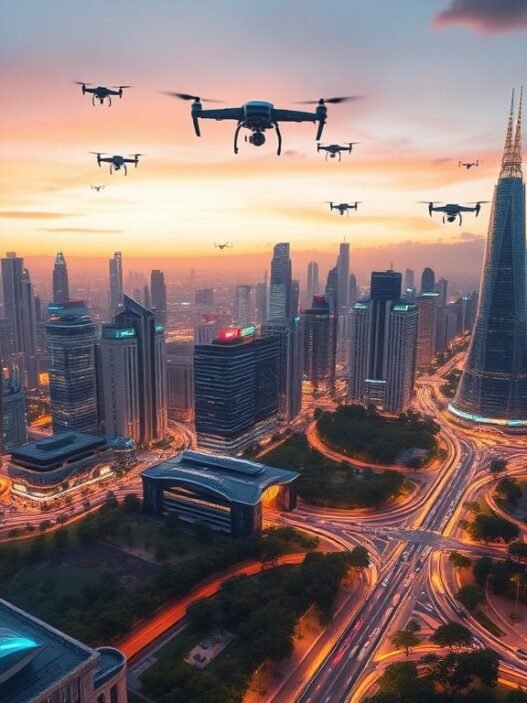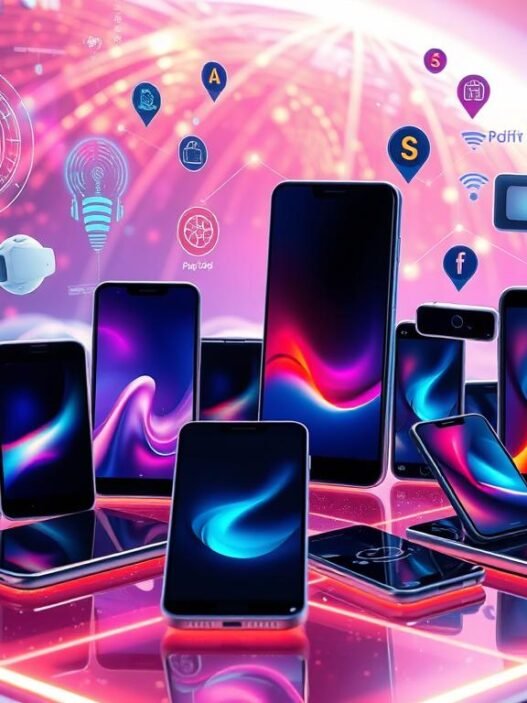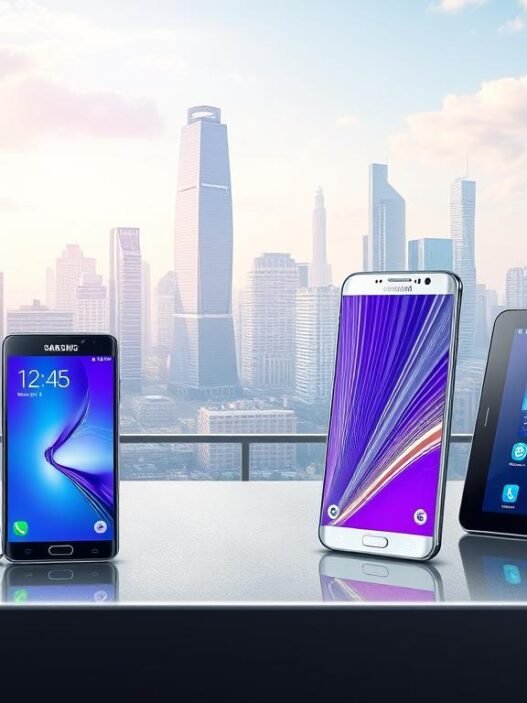Did you know AR technology helps people shop smarter? It makes them less likely to return what they buy. By looking into AR’s big changes, we see how it’s changing many areas. It creates immersive experiences, mixing the digital with the real.
Augmented Reality (AR) is a game-changer in how we see the world. It mixes real and virtual elements in new ways. AR is making shopping, learning, and even healthcare better. It’s bringing new digital layers to our daily lives, affecting everything from play to work.
Key Takeaways
- AR technology impact: AR enables consumers to make better purchasing decisions and minimizes returns.
- Immersive AR experiences: Offers personalized and interactive shopping experiences, driving brand loyalty.
- Transformative effects of AR: Enhances user engagement across retail, education, healthcare, and more.
- Digital and physical integration: Seamlessly blends real-world elements with virtual enhancements.
- Future of AR: Includes advancements in wearables and smart glasses, placing AR at the forefront of technology use.
Introduction to Augmented Reality (AR)
Augmented Reality (AR) emerged in 1990, thanks to Thomas Caudell from Boeing. It blends the real and digital worlds, creating immersive experiences. The technology’s first big breakthrough was in 1998 with a yellow first-down marker in football broadcasts. Since then, it has grown into different fields such as healthcare and marketing.
AR works by either recognizing special markers or without them. It’s making waves in retail, navigation, and fun activities. Devices like smartphones and smart glasses bring these experiences. For instance, apps like Snapchat show how AR can change what we see around us.
Companies like Apple and Meta are at the forefront with devices such as Apple Vision Pro. Thanks to tools like ARKit, they’re making AR more common on our phones. This has kick-started more competition and new ideas in the AR realm.
The U.S. Army uses AR for better navigation and knowing what’s around them. IKEA’s app helps people see how furniture looks in their home. Even in gaming, AR games like Pokémon Go create interactive fun.
In healthcare, AR helps in training and improving heart rehab. For example, medical students can look at the human body in 3D. This was shown in a study by Cleveland Clinic.
Google’s “Introduction to Augmented Reality (AR)” course is a hit, attracting over 93,000 sign-ups. It’s designed for beginners and takes 10 hours over three weeks. Graduates get a certificate they can share, beneficial for their career. The course delves into AR experiences, tools, and its uses.
AR is changing our interaction with the world, enhancing everything from learning to shopping. It promises more innovations for the future.
AR in Retail: Revolutionizing Shopping Experiences
Augmented Reality (AR) has changed the way we shop online and in stores. By using WebAR, it has made shopping smoother by linking the online and offline worlds. This makes shopping more fun and real.
AR lets customers see and try products in a real-world setting before buying. This helps lower return rates. Online returns are often higher (30%) than in-store returns (8.89%). AR can help solve issues with sizing and fit, leading to fewer returns.
Brands like Wayfair, L’Oreal, Nike, and Apple have used AR to improve shopping. L’Oreal’s partnership with Snapchat boosted virtual lipstick try-ons by 150%. GAP’s AR try-ons increased online denim sales by 30%.
In-store shopping has also benefited from AR. It allows for virtual try-ons, which reduces hygiene worries and lessens physical contact with products. An AR app from Adidas let shoppers try on shoes virtually. This increased brand interaction and awareness.
AR solves common retail problems like out-of-stock items and lack of personalization. It makes trying things out easy and merges online with in-store shopping. AR helps overcome language barriers and connects shoppers with products, improving ROI and shopping experiences.
AR can boost sales significantly. EQ3 saw a 112% increase in sales with their AR app for furniture visualization. Shopify found 63% of shoppers are more likely to buy from brands that offer AR. This shows AR’s big potential for retailers.
Yet, adopting AR is not without challenges. High-quality graphics and smooth integration with current systems are needed. There’s also a learning curve for new users. Investments in easy-to-use interfaces and customer education are essential.
The future of AR in retail promises more personal and engaging shopping experiences. Things like AR recommendations and virtual assistants could enhance customer satisfaction and encourage loyalty. Immersive shopping is set to become a key part of retail.
AR in Education: Boosting Engagement and Learning
Augmented Reality (AR) is changing how we learn. It makes learning fun and interactive. AR tools help students and teachers by creating new ways to learn. This tech is especially good for STEM subjects. It helps in seeing and understanding hard concepts better.
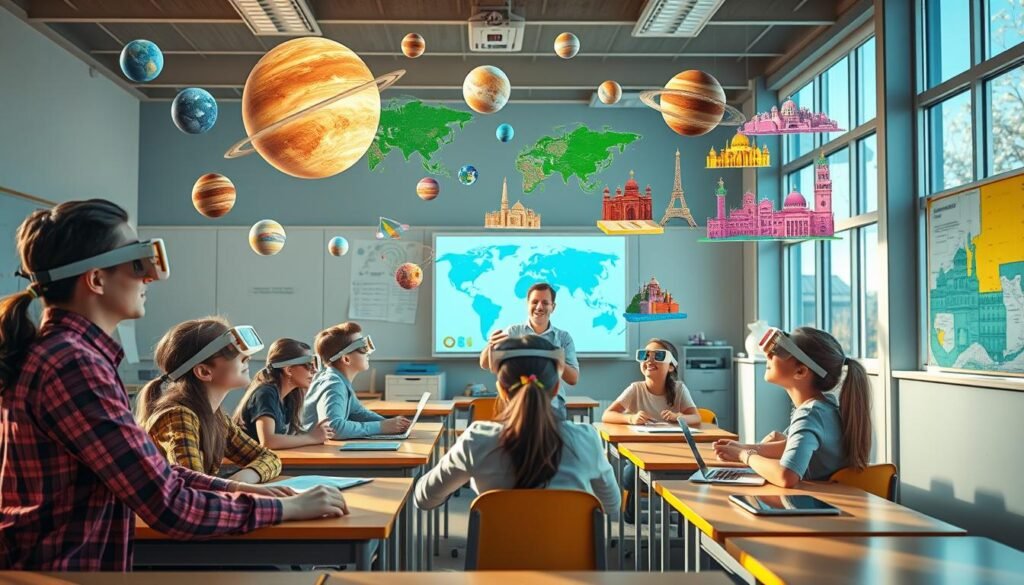
Interactive Learning Tools
AR is making classes more dynamic. Students can use AR apps to see digital info on real things. This makes hard ideas easier to grasp. It fits with Vygotsky’s idea that learning is social and best when shared. Learning this way helps students remember better.
Virtual Field Trips
Virtual field trips are a great use of AR in schools. Students can visit far-off places without leaving the classroom. These trips make learning about complicated things easier. Schools like the Episcopal School of Baton Rouge find VR and AR really boost student interest.
Personalized Learning Experiences
AR lets learning fit each student’s needs. With AR apps, learning can be more related to real life. This makes learning fun and effective. It lets students learn at their own speed on topics they like. Personalized education leads to better learning results. EdTech magazine talks about how AR in coding classes can make a big difference.
The use of AR in education is growing fast. It’s expected to increase from $10.37 billion in 2022 to $68.71 billion in 2026. This growth shows that AR is becoming key in learning. As AR technology gets better, learning will become more fun and accessible for everyone.
The Role of AR in Healthcare
Augmented Reality (AR) is changing the healthcare world. It helps in surgery, trains medical students, and educates patients. The FDA has approved 69 AR/VR medical devices. This shows how much AR is growing in the healthcare field.
AR is very important for surgeries. It helps surgeons see things better which makes surgeries safer. This technology lowers the chances of mistakes and helps patients recover better.
AR is also changing how medical students learn. They get to practice on realistic simulations. This means they can learn without risking people’s health. A study by Yoo et al. (2017) showed AR helps in learning how to control muscles in kids.
AR helps patients understand their health better. They get to see what is happening inside their bodies. This makes it easier for them to talk to their doctors and take care of their health.
“Integrating AR in healthcare is not just an innovation; it’s a transformation that enhances surgical precision, elevates medical training, and empowers patient education, fostering a more informed and equipped healthcare environment.” – Pelargos et al. (2017)
AR is used in different parts of healthcare like telemedicine and helping patients after surgery. It even helps new mothers learn how to breastfeed with visual guides. This makes learning much easier and accurate.
Lastly, AR helps with managing pain. It uses special environments and breathing techniques to help patients forget their pain. This makes their lives better.
| AR Integration in Healthcare | Application | Impact | Source |
|---|---|---|---|
| Surgical Procedures | Improved surgical precision | Reduced risks, better outcomes | FDA Data |
| Medical Training | Realistic simulations | Enhanced learning experience | Yoo et al. (2017) |
| Patient Education | Immersive health visualizations | Improved comprehension and engagement | Various Studies |
| Pain Management | Immersive environments | Chronic pain distraction | Clinical Reports |
Augmented Reality (AR) in Navigation and Wayfinding
Augmented Reality (AR) is changing how we navigate. It brings new tools to help users find their way. This includes heads-up displays and AR city guides.
AR in Vehicle Navigation
In car navigation, AR makes the experience better with heads-up displays. These displays show info right on the windshield. This lets drivers watch the road while getting directions. Brands like BMW and Mercedes-Benz have added AR displays to their cars. This mix of safety and convenience is a big step forward.
These systems also give live directions and highlight interesting spots on the way. Although GPS is still key outdoors, AR adds an interactive layer to it. It makes navigating more dynamic and user-friendly.
City Exploration with AR
AR city guides and location-based AR services change how we explore cities. Google’s “Live View” adds digital info to real-world views on smartphones. This helps people find their way more easily and with fun.
Apps like Pokémon Go have inspired location-based AR for city tours. They make walks through cities informative and enjoyable. Users learn about landmarks and local spots while exploring.
AR is great for finding your way in places like malls, airports, and hospitals. Things like beacons and AR markers make indoor navigation simple. For example, North American Properties reported a huge number of clicks and visits for their AR wayfinding. This shows people really engage with these services.
Insider Workforce 4.0 is a standout AR solution. It handles maintenance, defect management, and tracking assets. This example shows AR’s wide use across different fields worldwide.
Enhancing Social Interactions with AR
Augmented Reality (AR) has changed how we socialize. The COVID-19 pandemic saw more people using digital platforms to stay connected. AR makes these online interactions more immersive and fun.
AR blends the digital and real worlds by adding digital images to real environments. This makes social experiences through AR richer and more meaningful. People can have virtual hangouts or work together in AR settings.
AR messaging is a game-changer. It lets users send interactive messages, not just text and pictures. Imagine sharing a 3D virtual pet or an animated character that plays in your friend’s room. This makes chatting way more interesting.
AR is also changing how we workout from home. Cugusi et al. noticed a jump in fitness apps with AR during the pandemic. These apps use AR to make you feel like you’re in an actual gym. This boosts motivation and makes workouts more engaging.
| Feature | Benefits | Examples |
|---|---|---|
| AR in Communication | Immersive digital interactions | AR Video Calls |
| Augmented Social Experiences | Enhanced shared activities | Virtual Hangouts |
| AR Messaging | Interactive message content | 3D Model Sharing |
| Social AR Applications | Innovative collaboration tools | Virtual Pet Interactions |
AR is reshaping how we use social media. It enhances video calls, messaging, and fitness experiences. AR in communication is helping us enjoy deeper, more interactive social connections.
Immersive Entertainment and Gaming with AR
Augmented Reality (AR) is changing the game in both entertainment and gaming. It’s set to bring in over $50 billion in the next few years. With an expected growth rate of 10.77% from 2024-2028, AR’s future looks bright. Many young people, especially those between 16 to 34, are already using AR regularly.
AR in Museums and Exhibits
AR is transforming museum visits into interactive adventures. It lets visitors connect with history and art in new ways. The Smithsonian National Museum of Natural History, for example, offers an AR journey through ancient Egypt. This makes learning fun and turns museum visits into unforgettable experiences.
Location-based AR Games
Games like Pokémon GO show how popular AR gaming can be. With millions of players around the world, AR has taken entertainment to new levels. It combines the virtual with the real world to create a unique gaming experience. These games also promote exercise and meeting new people.
Augmented Storytelling
AR is revolutionizing storytelling by mixing real-life with digital enhancements. It engages people in a way that traditional stories can’t. AR also brings new experiences to music fans, like the 88rising and Microsoft project for Warren Hue’s “Boy of the Year,” which drew half a million visitors. AR apps at festivals also cut down on the need for paper schedules and maps.
AR will have a deep impact on entertainment, changing how we experience games, TV, music, sports, and theater. It’s making the line between audience and content fade away.
Challenges and Ethical Considerations in AR Adoption
The rise of augmented reality (AR) has brought many challenges in AR technology and ethical issues. The fast growth of AR in our daily lives highlights the need for ethical usage. A big worry is how it affects users’ privacy. For example, Pokémon GO launched in 2016 caused players to enter private places without permission. This raised AR privacy concerns.
Data security in AR poses another big challenge. The “DeepNude” app in 2019 showed the need for better data protection. This app created images without consent using AI. Plus, research by the Pew Center shows that 72% of AR users worry about privacy. Meanwhile, 67% are unsure about how their data is used. This shows that many people are concerned.
The Cambridge Analytica scandal highlighted misuse of personal data. While not directly related to AR, it showed the need for strong data security in AR too.
Also, making AR accessible and inclusive is challenging for developers. In 2019, the launch of “MedVR Training” made people question access due to VR’s high costs. AR must be made for everyone, including those with disabilities. This promotes inclusivity among users.
| Concerns | Statistics | Examples |
|---|---|---|
| Privacy Issues | 72% of users concerned | Pokémon GO trespassing |
| Data Security | 67% unsure about practices | “DeepNude” app misuse |
| Psychological Impact | 25% experience issues | VR horror game induced anxiety |
| Addiction Risks | 30% show addiction signs | Prolonged VR use |
There are also worries about how AR can affect the mind. The American Psychological Association notes that 25% of VR users face issues like feeling lost or detached. This brings up concerns about the mental health of those using immersive tech.
To tackle these ethical issues, everyone needs to work together. Developers should focus on ethical methods, responsibly make content, and be clear about data use. Users must be mindful of what they engage with and careful with their data. Important works, like Tatiana Fernández’s “Ethical Considerations for Virtual Reality and Immersive Experiences,” continue to explore these important topics.
Future Trends and Innovations in AR
The future of AR shows exciting changes ahead. We are looking at cool advancements in AR wearables like smart glasses. Plus, the growth in AR content development is something to watch. These trends mean we’ll experience and interact with our world in new ways.
AR Wearables and Smart Glasses
AR wearables, especially smart glasses, are changing how we work and play. Companies like Apple are leading with innovations. Their Apple Vision Pro is setting new standards for how augmented reality blends with our daily lives.
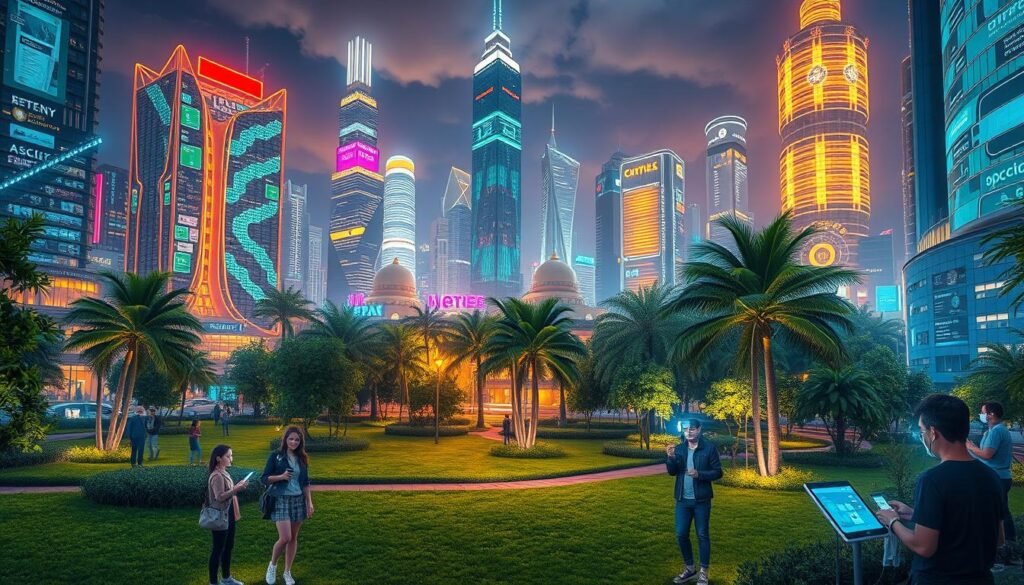
The next few years will bring major leaps in smart glasses. These won’t just change what we see. They will offer a hands-free, interactive experience. Such tools will be essential in fields like healthcare and education. They let us mix digital info with the real world.
| Year | Projected AR/VR Market Growth |
|---|---|
| 2020 | USD 6.1 billion |
| 2025 | USD 20.9 billion |
Advancements in AR Content Creation
The progress in AR content is also important. Tools powered by AI and machine vision are making AR more lifelike. AI helps create realistic human figures, identify objects, and understand text. This progress is opening up AR to more industries.
Take Apple’s ARKit 6 as an example. It brings 4K video, LiDAR scanner depth, and real-time motion capture. These features give developers what they need to make awesome AR apps. And these apps work on many devices.
WebAR is making AR easier to reach too. It lets people try AR through their web browsers. No special apps required. This ease of access means more people can enjoy AR. So, AR is becoming a key part of digital strategies.
Another highlight is the focus on comfortable AR/VR displays. These displays aim to deliver top-notch content without tiring the eyes. This focus will make using AR a better experience overall.
Looking ahead, we see a future filled with AR wearables and content creation leading the way. These innovations will change how companies work and how we all interact with the world. It’s an exciting time for AR technology.
Conclusion
As we conclude our journey, we see Augmented Reality (AR) changing many areas. Areas like retail, education, healthcare, and entertainment have transformed. AR makes our daily experiences better, offering interactive realities. In retail, it changes how we shop by letting us see products in real settings. Education gets more engaging through interactive tools and virtual trips. Healthcare sees advances in surgery planning and patient care with AR.
AR’s use in navigation, social media, and entertainment is also important. Navigation apps with AR make travel and exploring cities better. Social networks use AR for fun filters. Entertainment benefits from AR with immersive games and new ways to enjoy museums and shows. These uses of AR show how flexible it is and its future promise.
The future of AR is filled with exciting developments. Wearables and smart glasses will bring AR into our daily lives even more. But, as we move forward, we must tackle challenges and think about ethics. Keeping user privacy and data security is key as AR grows in our society. AR will keep improving how we see and interact with the world. It’s clear that AR has a big role in making our experiences richer as it keeps evolving.











